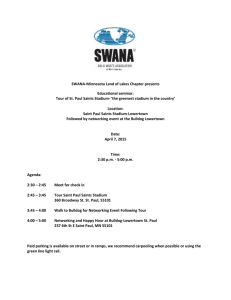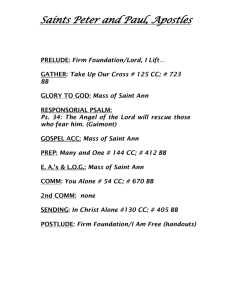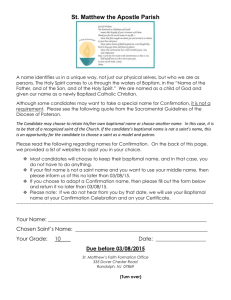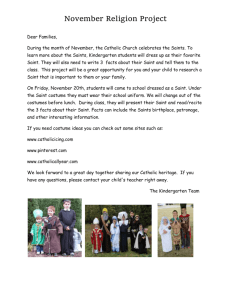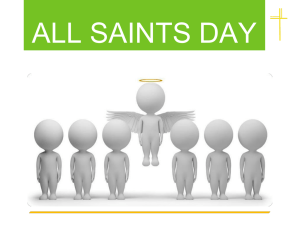Between Baptism and Revelation
advertisement
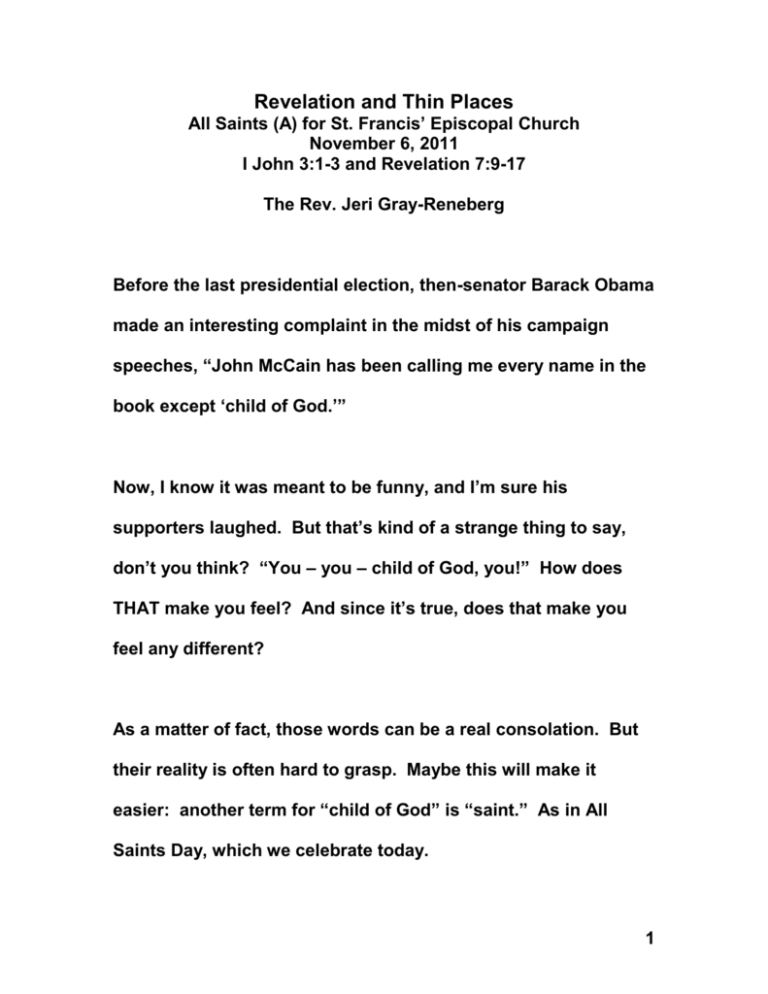
Revelation and Thin Places All Saints (A) for St. Francis’ Episcopal Church November 6, 2011 I John 3:1-3 and Revelation 7:9-17 The Rev. Jeri Gray-Reneberg Before the last presidential election, then-senator Barack Obama made an interesting complaint in the midst of his campaign speeches, “John McCain has been calling me every name in the book except ‘child of God.’” Now, I know it was meant to be funny, and I’m sure his supporters laughed. But that’s kind of a strange thing to say, don’t you think? “You – you – child of God, you!” How does THAT make you feel? And since it’s true, does that make you feel any different? As a matter of fact, those words can be a real consolation. But their reality is often hard to grasp. Maybe this will make it easier: another term for “child of God” is “saint.” As in All Saints Day, which we celebrate today. 1 Today, we recognize all the saints, those we have known and loved who are no longer with us but are fully present to God, and those who are still living – children of God, of the past, present and future. If I asked you to describe what a saint looks like, the easiest thing to do would be to turn and describe the person sitting next to you. Barbara Brown Taylor, in her book, “Mixed Blessings,” tells the story of how a church tied their Halloween celebration to a celebration of All Saints. They did this by inviting everyone to come to a party dressed as their favorite saint. She says, “Most people followed the instructions. Saint Paul was there, as well as Saint Francis. Saint Nicholas made an appearance, and Saint John the Baptist showed up too, after he had been beheaded, with his head on a silver platter overflowing with fruit and a cardboard box hiding the rest of his body. 2 St. Louis was there, but in this case, it was the city, not the person. The woman had a huge silver arch above her head, complete with a label - Gateway to the West. Then there were a few who did not follow the instructions at all, or maybe they just had a better understanding of what the word saint meant. There were a couple of cowboys present, one of which who looked a lot like Kenny Rogers. There were a few Native Americans, complete with warpaint. And many people came dressed in the costumes of nurses and doctors, construction workers and police officers, firefighters and even a politician or two. One person even dressed up as a pastor. Imagine that! 3 At the end of the party awards were given out to those with the best costumes, and then everyone was given a glittery halo to wear.” Taylor says, “My guess is that they were made with Christmas tinsel, but they were beautiful things that hovered over every person's head, just like the real thing might. And then everyone marched into the church sanctuary and took their place for a time of worship – halos bobbing and swaying and sparkling in the light of candles. I was amazed at how funny and eerie and even beautiful this all looked. There were all kinds of people there, from all the different times and places on earth, and binding them all together, making them one, were those delicate, beautiful halos, 4 linking each person with the others and everyone there with all God's saints in all times and places. And that, my friends, is how it should be.” In our second lesson from the book of First John, we read, “Beloved, we are God’s children now; what we will be has not yet been revealed.” What we will ultimately be has not yet been revealed. We are all odd, distinctive, beautiful people created by God, but in some ways, we all remain a mystery, even to ourselves. We think we are defined by what we accomplish, by our physical, emotional and mental characteristics, by the ways in which we love other people. But under the tangible, under the apparent, is the part of us that is hidden, known at this point only to God. Ironically, one of our other texts for today comes from the book of Revelation. But for those of us who are contemporary Christians, John’s words in that book are anything but plain and 5 straightforward. We can’t know precisely what John meant by statements like, “These are they who have come out of the great ordeal; they have washed their robes and made them white in the blood of the Lamb.” The word “revelation,” as in “the book of Revelation,” is in Greek, apocalypsis – revelation or uncovering. But for us, John’s words remain mysterious, strange, vivid, yet compelling. Some are strikingly beautiful and wonderful to ponder, like the words we hear today. Celtic spirituality has often talked about glimpsing God through the “thin places” in the world. The same might be said about the Community of Saints. There are several “thin places” in which, if we pay attention, we can catch a glimpse of the Community of Saints through time and space, and our place as unique members of that Community. Without stretching the Revelation text too much, we might imagine that WE are those “who have washed (our) robes and made them white in the blood of the Lamb” – in baptism, in dying to sin through Christ our Lord, we are forgiven children – or saints – of God. 6 So two of the “thin places” are baptism – where we are “drowned,” anointed, given a symbolic baptismal garment, and presented with a candle to symbolize the light of the Holy Spirit that now lives in us – and the Affirmation of Baptism, also known as Confirmation. Next April, Erin Wall will be confirmed by Bishop Beisner in a regional confirmation at Christ Church, to which you are all invited. There, we will hear her own affirmation of the vows that were made for her as a child. At the same time, others will reaffirm the faith into which they were previously confirmed, and others will be received from other churches. Another of the “thin places” where we catch a glimpse of the Community of Saints is at the Table of the Lord, the Holy Eucharist. We affirm the mystery of the whole Body of Christ, across time and space, as we receive the bread and the wine, the real presence of Christ’s body and blood. We know our sins to be forgiven. We are reconstituted into the community of the saints of God every time we gather at the table, which is why we are eager to do so as often as possible. 7 Finally, the last “thin place” is the Christian funeral. One of the things that can designate a baptized saint of God is the white funeral pall, which I’ve mentioned before. It is a white cloth that covers the casket or coffin, or the urn which holds cremated ashes. Melinda Quivik describes its purpose in the book, “A Christian Funeral: Witness to the Resurrection,” “Baptism is visible as the pool or font of water, as the paschal candle lit at the head of the coffin to show the presence of Christ, and in the white pall or cloth laid on the coffin. The pall is somewhat unfamiliar… but has found more widespread use since the liturgical reforms of the 1960s and 1970s. To my great joy, one of the funeral businesses (in my town) offered to purchase a funeral pall for the churches I served… Our congregations were pleased to have the pall not only because it… proclaimed the primacy of baptismal identity, but it also hid the coffin from view, making it impossible to judge the amount of money spent by the family. Both rich and poor alike came before God and the mourners, looking the same in the fine baptismal clothing given by the church.” 8 The author adds, “Receiving Holy Communion at a funeral is also a tangible expression of the communion of saints. As a meal eaten by the church, it brings to mind the whole church on earth and in heaven.” Again, in the words of First John, “What we will be has not yet been revealed. What we do know is this: when he is revealed, we will be like him, for we will see him as he is.” So take heart, children of God, saints in the Lord! We are robed in white, washed in the blood of the Lamb. We stand in a crowd of saints that began before us and will continue after us. We see some of those faces here today, and remember also those who are no longer with us, whom we will see again sometime in God’s future, when Christ the Lamb is revealed on his throne, and we are revealed to be like him. We are God’s children now; we are God’s forever. Alleluia! Amen. 9

